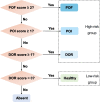RegEMR: a natural language processing system to automatically identify premature ovarian decline from Chinese electronic medical records
- PMID: 37464410
- PMCID: PMC10353087
- DOI: 10.1186/s12911-023-02239-8
RegEMR: a natural language processing system to automatically identify premature ovarian decline from Chinese electronic medical records
Abstract
Background: The ovarian reserve is a reservoir for reproductive potential. In clinical practice, early detection and treatment of premature ovarian decline characterized by abnormal ovarian reserve tests is regarded as a critical measure to prevent infertility. However, the relevant data are typically stored in an unstructured format in a hospital's electronic medical record (EMR) system, and their retrieval requires tedious manual abstraction by domain experts. Computational tools are therefore needed to reduce the workload.
Methods: We presented RegEMR, an artificial intelligence tool composed of a rule-based natural language processing (NLP) extractor and a knowledge-based disease scoring model, to automatize the screening procedure of premature ovarian decline using Chinese reproductive EMRs. We used regular expressions (REs) as a text mining method and explored whether REs automatically synthesized by the genetic programming-based online platform RegexGenerator + + could be as effective as manually formulated REs. We also investigated how the representativeness of the learning corpus affected the performance of machine-generated REs. Additionally, we translated the clinical diagnostic criteria into a programmable disease diagnostic model for disease scoring and risk stratification. Four hundred outpatient medical records were collected from a Chinese fertility center. Manual review served as the gold standard, and fivefold cross-validation was used for evaluation.
Results: The overall F-score of manually built REs was 0.9444 (95% CI 0.9373 to 0.9515), with no significant difference (paired t test p > 0.05) compared with machine-generated REs that could be affected by training set sizes and annotation portions. The extractor performed effectively in automatically tracing the dynamic changes in hormone levels (F-score 0.9518-0.9884) and ultrasonographic measures (F-score 0.9472-0.9822). Applying the extracted information to the proposed diagnostic model, the program obtained an accuracy of 0.98 and a sensitivity of 0.93 in risk screening. For each specific disease, the automatic diagnosis in 76% of patients was consistent with that of the clinical diagnosis, and the kappa coefficient was 0.63.
Conclusion: A Chinese NLP system named RegEMR was developed to automatically identify high risk of early ovarian aging and diagnose related diseases from Chinese reproductive EMRs. We hope that this system can aid EMR-based data collection and clinical decision support in fertility centers.
Keywords: Diminished ovarian reserve; Electronic medical records; Natural language processing; Ovarian reserve; Premature ovarian failure; Premature ovarian insufficiency.
© 2023. The Author(s).
Conflict of interest statement
The authors declare no competing interests.
Figures








References
-
- Sun H, Gong TT, Jiang YT, Zhang S, Zhao YH, Wu QJ. Global, regional, and national prevalence and disability-adjusted life-years for infertility in 195 countries and territories, 1990–2017: results from a global burden of disease study, 2017. Aging (Albany NY) 2019;11:10952–10991. doi: 10.18632/aging.102497. - DOI - PMC - PubMed
-
- Barratt CLR, Björndahl L, De Jonge CJ, Lamb DJ, Osorio Martini F, McLachlan R, Oates RD, van der Poel S, St John B, Sigman M, et al. The diagnosis of male infertility: an analysis of the evidence to support the development of global WHO guidance-challenges and future research opportunities. Hum Reprod Update. 2017;23:660–680. doi: 10.1093/humupd/dmx021. - DOI - PMC - PubMed
-
- Nguyen HH, Milat F, Vincent A. Premature ovarian insufficiency in general practice: Meeting the needs of women. Aust Fam Physician. 2017;46:360–366. - PubMed
Publication types
MeSH terms
LinkOut - more resources
Full Text Sources
Medical

